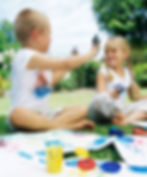Teacher Talk: Observing Sensorial Development

We can sometimes underestimate the power of the Sensorial materials, thinking about them only as simple activities that let children practice using their senses. They are great practice- that's true- but they're also important tools for teacher observation, to understand children's development and the refinement of the tools through which the rest of the curriculum will unfold. It's important, then, to think about what to look for when you're observing children's sensory development. Consider these benchmarks:
Children between six and twelve months should generally be able to imitate gestures they've observed in their environment. They will be able to move their tongues around in their mouths and to manipulate food in their mouths with their tongues. They open their mouths to be fed and will accept a diverse palate of textures. Look for an aversion to different textures in food and clothing, or for a hypersensitivity to temperature changes, and offer isolated practice from simple to complex experiences to meet children where they are.
Children between one and two years should express discomfort when their diapers are soiled. They are able to distinguish between things they can eat and things they should not and can discern risky stimuli, like heat, height, or glass. They may react strongly to temperature extremes, although they often delight in very messy play with textures that slop or swish or smear. They can repeat sounds they hear and will look for missing items, under the table, under the couch, behind things, etc. Look for disjointed interest in play, an aversion to new stimuli or difficulty tolerating sensorial changes. Remember that children at this age are still often overwhelmed by too much stimulation at once, and respond with simpler, quieter environments.
Children between two and three years old should be able to manage sitting on diverse surfaces. They explore their environments openly and are able to discern differences in texture, weight, hand, and shape. They can match simple shapes and match objects. Look for delays in their interest for toileting, or sensitivities to new stimuli. Look for connections, or the lack there of, to other children and adults or frustration with attention, as these may be early indications of visual or auditory integration.
Children between three and four years old should be able to identify most colors and manage their own clothing. They show an interest in fasteners and laces, buttons and zippers. They can feed themselves independently and remember sounds, shapes, movements, etc. as they incorporate their observations into creative play. Look for social skills to develop and for the child to be able to follow increasingly difficult sequences of instructions as they are able to imagine and remember more acutely.
Children between four and five years old should be able to discern subtle differences between visual, auditory, gustatory, olfactory and tactile stimuli. Indeed, they delight in these opportunities and demonstrate an interest in unusual stimuli across their senses. Look for frustration integrating these stimuli at once, and simplify the environment for children as they weave the multiple messages they are getting from their senses.
Children between five and six years old should be able to see reliably, to write letters and numerals with ease and to imagine different perspectives than their own view. They can categorize objects by multiple qualities and can re-create shapes with ease. They can hear rhymes consistently, mix colors and imagine shapes and qualities in their minds. Look for examples of their developing memories and their ability to relate stories, predict and imagine.
Children between six and seven years old should be able to use their sensorial perception to communicate consistently, to describe what they see and what they have experienced with reliability and to classify objects by qualities independently. They have moved into a more abstract internalization of sensorial qualities: while they still benefit from extensive practice with diverse sensorial stimulation, they have the cognitive development to imagine without the benefit of objects in their hands.
As children develop the ability to discern and classify the information they receive through their senses, they are simultaneously practicing the ability to integrate all that information at once. For younger children, they may only be able to make sense of a few sensorial stimuli at once. For older children, you won't even notice the integration because it should, for typical development, be seamless. But because children can't "turn off" their sensorial awareness, struggles with integration can appear in other ways: through children's behavior, their attention span, their social skills, even their eating habits. When you observe a child struggling with a new concept or challenge, remember to consider the tools the child needs to engage that concept. The sensorial tools of sight, taste, touch, smell and hearing should, with enough practice, patience and time, ultimately work together so smoothly that you barely notice them as separate skills. In the meantime, there's a Sensorial material for just about every developing skill. It just takes attentive observation to make the best connection.
